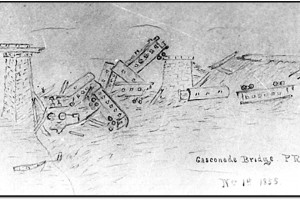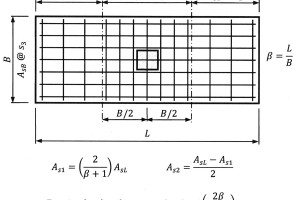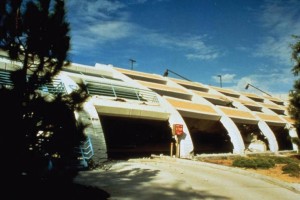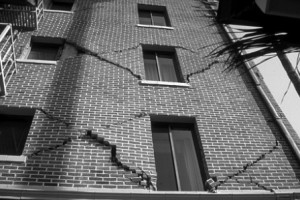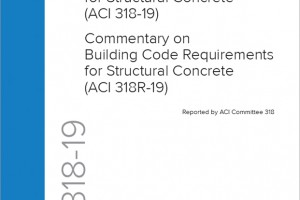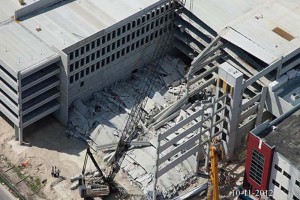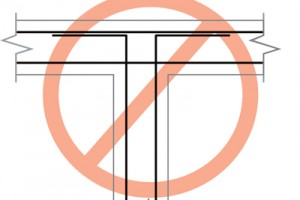The Pacific Railroad was chartered in Missouri in 1849 to build a railroad from St. Louis to the Pacific Ocean. Due to financing problems and outbreaks of cholera, construction did not begin until 1851 with a groundbreaking at which prominent citizens of St. Louis turned out to celebrate the start of construction of the line. It included speeches, a national salute, and the reading of a poem written for the moment in history. …
Review Category : Articles
Part 5: Foundations
Spread Footings
Flexural Reinforcement
Requirements for the distribution of flexural reinforcement in two-way footings are given in Sections 13.3.2.2 and 13.3.3.3 of ACI 318-14, Building Code Requirements for Structural Concrete. For square footings, the reinforcement is to be distributed uniformly across the entire width of the footing in both directions. In the case of rectangular footings, the reinforcement must be distributed in accordance with the requirements in Section 13.3.3.3 of ACI 318-14, which are illustrated in Figure 1. Reinforcement in the long direction is uniformly distributed across the entire width. A portion of the reinforcement in the short direction is uniformly banded over the column with the remainder uniformly distributed outside of the band width. …
Performance and Resulting Building Code Changes
One of the most iconic images of the 1994 Northridge Earthquake is the photograph of a collapsed precast concrete parking structure at California State University, Northridge. While it was only one of many precast parking structures that suffered extensive damage as a result of the earthquake, it illustrates the juxtaposition of the incredible ductility exhibited by the perimeter columns with the collapse of the overall structure. It epitomizes one of the primary performance issues highlighted by the earthquake. The failure of numerous concrete parking structures during the earthquake, both precast and cast-in-place, led to an in-depth examination of the current design practices and ultimately led to several building code changes to improve the performance of these types of structures. …
Developers, owners, general contractors, and subcontractors all face a similar dilemma. How can fantastic projects be created when they cost so much? Competition for land, difficult entitlements, and rising construction costs remain ongoing challenges facing the mandate to build, particularly housing. Material and equipment scarcities, code and regulation intensifications, and the lack of available skilled labor all contribute to decreased productivity. Inadequate housing and transportation create shortages of local labor while insatiable demand continues to outpace supply, all leading to soaring construction costs. …
Continuous improvement through sharing lessons from failures, near misses, and similar incidents is critical to any profession or industry. In the U.S. structural engineering community, we have long used publications, conferences, and university curricula for this purpose. However, we now have a new, robust tool for learning from failures through the recently launched system Confidential Reporting on Structural Safety in the US (CROSS-US). …
Concrete and masonry members can experience cracking due to their low tensile strength. Cracking can occur for a variety of reasons, including loads, shrinkage, temperature, settlement, or stresses induced by seismic and wind activity. Figure 1 shows diagonal cracks in masonry walls caused by an earthquake. Since cracks can have a significant negative impact on anchor performance, the assumption that an anchor is situated in a crack is not conservative, especially during seismic behavior. For concrete members, building codes require the structural design to address the effects of cracks on post-installed and cast-in-place anchors. Anchors must be evaluated and the structural designer must determine design data. However, for masonry members, there is no provision for considering the impact of cracks on anchor performance. This article presents the results of an experimental program addressing testing and evaluation of anchorage performance in cracked masonry. …
Building Code Requirements for Structural Concrete
The American Concrete Institute (ACI) published ACI 318-19, Building Code Requirements for Structural Concrete, in June 2019. This edition of ACI 318 is the first to be published since the format of ACI 318 was reorganized in 2014. It includes new and updated code provisions as well as color illustrations and interactive links in its online version. …
Today, structural engineers are aggressively seeking low-carbon building materials to reduce the carbon footprint of the built environment. Numerous advances in concrete technology are providing solutions in response to these goals and working toward an aspiration of net-zero carbon emissions for future new construction. Even though decades of work have been performed using advances that can move the industry in that direction, they have not always made their way effectively into project specifications. The 2014 update to ACI 318, Building Code Requirements for Structural Concrete and Commentary, moved toward performance-based concrete specifications, which has facilitated the ability to use some of these advances. …
Structural grouting is an integral part of precast concrete, steel, and tilt-up construction. Currently, there are no requirements in building codes or standards for the installation or special inspection of grouted joints. The lack of attention to the timeliness of structural grouting has led to structural failures in both precast concrete and steel-framed structures. …
Part 4: Walls
This article is the fourth in a series on recommended reinforcement details for cast-in-place concrete construction. Parts 1, 2 and 3 ran in June, July, and August 2019 of STRUCTURE. …

